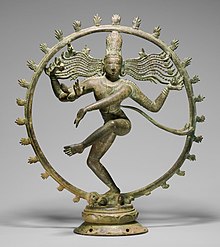User:Johnbod/Lining
Art and architecture
[edit]
India has a very ancient tradition of art, which has exchanged many influences with the rest of Eurasia, especially in the first millenium, when Buddhist art spread with Indian religions to Central, East and South-East Asia, the last also greatly influenced by Hindu art.[1] Thousands of seals from the Indus Valley Civilization have been found, usually carved with animals, but a few with human figures. The Pashupati seal is the best known.[2] After this there is a long period with virtually nothing surviving, after which almost all surviving ancient Indian art is in various forms of religious sculpture in durable materials, or coins. There there was probably originally far more in wood, which is lost. In north India Mauryan art is the first imperial movement, and the Lion Capital of Ashoka from about 250 BCE is now India's national symbol.[3] Over the following centuries a distinct Indian style of sculpting the human figure developed, with less interest in articulating precise anatomy than ancient Greek sculpture but showing smoothly-flowing forms expressing prana ("breath" or life-force).[4] This is often complicated by the need to give figures multiple arms or heads, or represent different genders on the left and right of figures, as with the Ardhanarishvara form of Shiva and Parvati.[5]
Most of the earliest large sculpture is Buddhist, either excavated from Buddhist stupas such as Sanchi, Sarnath and Amaravati,[6] or is rock-cut reliefs at sites such as Ajanta, Karla and Ellora. Hindu and Jain sites appear rather later.[7] In spite of this complex mixture of religious traditions, generally, the prevailing artistic style at any time and place has been shared by the major religious groups, and sculptors probably usually served all communities.[8] Gupta art, at its peak between about 300 CE and 500 CE, is often regarded as a classical period whose influence lingered for many centuries after; it saw a new dominance of Hindu sculpture, as at the Elephanta Caves.[9] Across the north, this became rather stiff and formulaic after about 800 CE, though rich with finely carved detail in the surrounds of statues.[10] But in the South, under the Pallava and Chola dynasties, sculpture in both stone and bronze had a sustained period of great achievement; the large bronzes with Shiva as Nataraja have become an iconic symbol of India.[11]
Ancient painting has only survived at a few sites, of which the crowded scenes of court life in the Ajanta Caves are by far the most important, but it was evidently highly developed, and is mentioned as a courtly accomplishment in Gupta times.[12] Painted manuscripts of religious texts survive from Eastern India about the 10th century onwards, most of the earliest being Buddhist and later Jain. No doubt the style of these was used in larger paintings.[13] The Persian-derived Deccan painting, starting just before the Mughal miniature, between them give the first large body of secular painting, with an emphasis on portraits, and the recording of princely pleasures and wars.[14] The style spread to Hindu courts, especially among the Rajputs, and developed a variety of styles, with the smaller courts often the most innovative, with figures such as Nihâl Chand and Nainsukh.[15] As a market developed among European residents, it was supplied by Company painting by Indian artists with considerable Western influence.[16] In the 19th century, cheap Kalighat paintings of gods and everyday life, done on paper, were urban folk art from Calcutta, which later saw the Bengal School of Art, reflecting the art colleges founded by the British, the first movement in modern Indian painting.[17]
- ^ Rowland, 185–198, 252, 385–466
- ^ Craven, 14–16; Harle, 17–18
- ^ Craven, 35–46; Rowland, 67–70; Harle, 22–24
- ^ Craven, 22, 88; Rowland, 35, 99–100
- ^ Craven, 18–19; Blurton, 151
- ^ Harle, 32–38
- ^ Harle, 43–55; Rowland, 113–119
- ^ Blurton, 10–11
- ^ Craven, 111–121; Michell, 44–70
- ^ Harle, 212–216
- ^ Craven, 152–160; Blurton, 225–227
- ^ Rowland, 242–251; Harle, 356–361
- ^ Harle, 361–370
- ^ Craven, 202–208; Harle, 372–382, 400–406
- ^ Craven, 222–243; Harle, 384–397, 407–420
- ^ Craven, 243; Michell, 210
- ^ Michell, 210–211; Blurton, 211
- Blurton, T. Richard, Hindu Art, 1994, British Museum Press, ISBN 0 7141 1442 1
- Craven, Roy C., Indian Art: A Concise History, 1987, Thames & Hudson (Praeger in USA), ISBN 0500201463
- Harle, J.C., The Art and Architecture of the Indian Subcontinent, 2nd edn. 1994, Yale University Press Pelican History of Art, ISBN 0300062176
- Michell, George (2000), Hindu Art and Architecture, 2000, Thames & Hudson, ISBN 0500203377
- Rowland, Benjamin, The Art and Architecture of India: Buddhist, Hindu, Jain, 1967 (3rd edn.), Pelican History of Art, Penguin, ISBN 0140561021
======================================
[edit]- Tate paper
- Lining, Relining and the Concept of Univocity
- images
- Q&A
- pp 409–450? Conservation of Easel Paintings (Google eBook), Joyce Hill Stoner, Rebecca Rushfield
Routledge, 15 Feb 2013
- FR: Lining paintings: papers from the Greenwich Conference on Comparative Lining Techniques, Caroline Villers, Archetype, 2003, http://dx.doi.org/10.1053/j.gastro.2014.01.046
http://dx.doi.org/10.1053/j.gastro.2014.01.046
2021 xmas card

|
Season's Greetings | |
| Wishing everybody a Happy Holiday Season, and all best wishes for the New Year! Adoration of the Kings (Bramantino) is my Wiki-Christmas card to all for this year. Johnbod (talk) 14:50, 22 December 2021 (UTC) |
